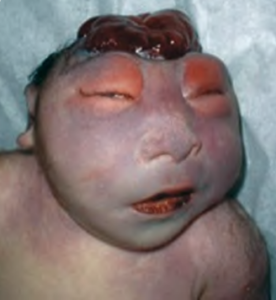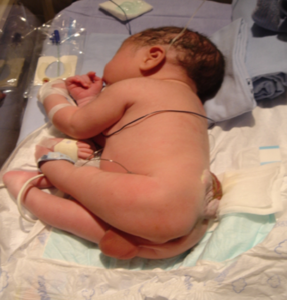In conjunction with Spina Bifida and Hydrocephalus Awareness Month, Spina Bifida Association of Malaysia (SIBIAM) presents a series of articles modified from our website (http://www.sibiam.my) and the Beyond the Cord quarterly newsletter – an initiative by the District Action Group on Spina Bifida and Hydrocephalus (DASH), Rotary District 3300. This article originally appeared in Beyond the Cord (January to March 2021) and has been updated to include latest Ministry of Health announcements on mandatory folic acid fortification.

Figure 1 – A newborn baby with anencephaly
Neural tube defects (NTD) are birth defects of the nervous system. The most common cause of NTD is deficiency of folic acid in mothers at the time just before and during their early pregnancy, when the nervous system in their embryos are being formed and developed. Deficiency of folic acid interferes with normal formation and development of the nervous system. There are many types of neural tube defects. The most common defects in Malaysia are anencephaly and spina bifida with myelomeningocoele.
Babies born with anencephaly have absence of most of the skull and brain (Fig 1). These babies usually do not survive for long – from a few days to weeks after birth. Currently there is no specific treatment for anencephaly except palliative care and support to the families, as well as counselling on prevention of recurrence, which is to supplement with folic acid during the future pre-pregnancy period.
Babies born with spina bifida have defects in their spine with abnormal formation and protrusion of their spinal cord; this is called myelomeningocoele. The extent of associated impairments affecting their limbs, bladder, bowel, breathing and development of the brain depends on the size and location of the defect, as well as the structures involved (Fig 2). If the defect is large with no protective skin over it, these babies can develop infection very fast and die shortly after birth.

Figure 2 – A baby with spina bifida and mylomenigocoele of the lower back
Babies with myelomeningocoele require urgent neurosurgery to close the exposed neural tissues to prevent further damage and infection. Very often these newborn babies may need to have a tube called a ventriculoperitoneal (VP) shunt which drains excess cerebrospinal fluid (CSF) into the abdomen because the structural abnormalities prevent normal drainage of CSF.
Because of the multiple medical issues associated with NTD, children with spina bifida need many consultations and visits with a multidisciplinary team of healthcare providers and allied healthcare personnel to help them through both childhood and adulthood. From time to time, their VP shunt might get blocked or dislodged, needing repeated neurosurgical correction.
After the initial urgent surgeries, parents will be trained to insert a urinary catheter periodically into these babies’ bladders (clean intermittent catheterisation, or CIC) because some children will not be able to pass urine normally. There is increased risk of recurrent urinary obstruction and infection with eventual kidney damage. They often also have bowel incontinence, therefore needing medication and diapers. The issues with passing urine and faeces is made more challenging with weakness of the lower limbs; this results in difficulty in mobility so they need help with hygiene.
Other than weakness, often there is loss of sensation to the lower part of the body. This puts the child at risk of joint contractures, skin injury, pressure injury and infections.
All these multiple and recurrent problems interfere with normal growth and development as well as psychological well-being throughout childhood, school-going period and adult life. These medical problems also pose a heavy economic burden on the family and society because the affected child needs frequent hospital visits, various treatment and support, also orthoses and wheelchairs to improve mobility. There is lifelong absence from school and work due to healthcare needs, physical and occupational therapy. The spina bifida child’s support system is also affected. Parents, siblings and other caregivers often give up their work or education opportunities to carry out caregiver duties.
In Malaysia, there is still a lot of room for improvement in the levels of rehabilitation and socio-economic support with families with NTD. They need financial assistance to obtain walking aids, lower limb braces, wheelchairs. Many families have to move to assess special schooling facilities and skill training due to lack of these resources in the community.
In high income countries, the incidence of NTD has decreased remarkably due to the implementation of mandatory food fortification with folic acid, for example in flour and rice. In Malaysia, NTD is still common, particularly in some parts of the country such as Kedah, Ipoh and Kuala Lumpur.
We welcome the April 2022 announcement by Health Minister Khairy Jamaluddin about the cabinet approval to make it mandatory for manufacturers to add folic acid and iron into their 25kg wheat flour packages. We hope there are future plans to also fortify rice products as rice is a staple in the Malaysian diet. Educating all school-going children to have a balanced diet including green leafy vegetables which are rich in folic acid will also be helpful.
By Dr Boo Nem Yun, Emeritus Professor, Faculty of Medicine and Health Sciences, Universiti Tunku Abdul Rahman. Edited and updated by Dr Chua Li-Shun.
World Spina Bifida and Hydrocephalus Day is celebrated annually on 25 October. This year’s theme is “Elevate Your Voice”. SIBIAM is celebrating the day with a colouring competition for spina bifida children, themed “My Voice Matters”, and writing competition for spina bifida teens and adults with the theme “Inclusion is the Solution”. For more information, email info@sibiam.my.
